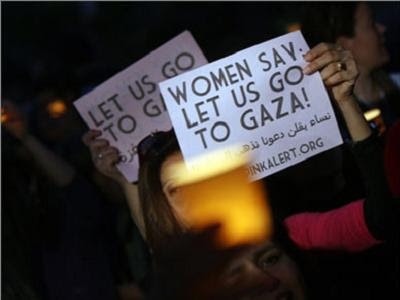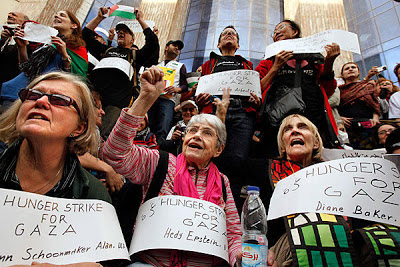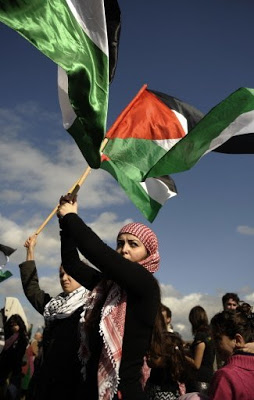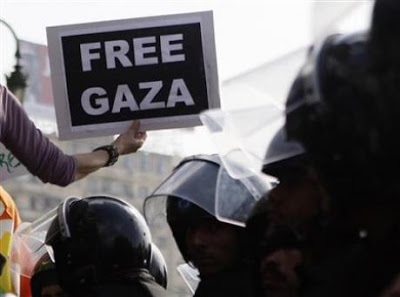UPDATE: See ‘Gaza Freedom march converges on Midan Tahrir,’ Below.
A Movement reimagining change:
Freedom marchers head for Gaza
By Bernardine Dohrn / The Rag Blog / December 31, 2009
More on the Gaza Freedom March, Below.
CAIRO — It has been a tumultuous 15 hours. Two buses, carrying 100 people from the GFM and loads of humanitarian supplies, just departed from Cairo for Gaza. This was a victory and a concession. The decisions and the manner in which this opportunity was framed and promoted by various actors fractured the GFM participants in familiar and unlikely, real and sectarian ways — all documented by media cameras and hundreds of Egyptian security forces.
Ali Abunimah, Veterans for Peace organizers, Israeli journalist Amira Hess, and this writer were among the 100 people on the list to go, who arrived at 6:30 this morning, on the corner of Ramsis by the 6th October Bridge at the Al Gona Bridge, to depart for Gaza.
Tuesday morning, delegates from several countries went to their embassies in Cairo to plead for help getting to Gaza. Most were met with predictable bureaucratic intransigence. The French, however, staged an extraordinary encampment in front of their embassy and their ambassador and his wife came out and spent time speaking with them individually and in small groups.
That action continues today. Bill [Ayers] and I went to the American Embassy at 10 a.m. and asked to see the Ambassador. We were ushered into a holding pen a block away from the embassy building where we joined 35 people already there, surrounded by Egyptian soldiers. Over the next four hours, another dozen Americans arrived, and those of us who asked to leave were denied.
Meanwhile, Medea Benjamin, Kit Kiteredge, and Ali Abunimah were meeting with an embassy official and stressing that we intended to go to Gaza on a nonviolent, humanitarian mission, and requesting their assistance. Further, they asked that the embassy officials release the U.S. citizens who were now clearly being detained outside.
Ali emerged first to tell us that their discussion achieved nothing, and they were now requesting that we be free to go. This process took another hour. Ali refused to enter the holding cage, and spoke to us from outside. At one point, out of nowhere, military personnel grabbed Ali, and Medea — who was standing a few feet away — sprang to action, shouting “No! No!” and grabbing Ali’s arm and pulling him down to the ground with her. As soon as they were prone, the security backed off. It was an impressive display of nonviolent direct action and solidarity in-the-moment, performed with speed, force and clarity.
In late afternoon, a huge demonstration took place outside the Syndicate of Journalists, a traditional site of political mobilizations in downtown Cairo. The GFM was a force, and joined by large numbers of Egyptian citizens chanting in solidarity with Palestine and in opposition to the visit that day by Netanyahu. This action got widespread coverage throughout the Arab world.
Late last night, it was announced at the nightly team leaders’ meeting that our three days of actions across Cairo, the international pressure around the world, and consistent efforts by CodePink leadership to meet with high level Egyptian officials — including a meeting yesterday at the offices of Suzanne Mubarak — resulted in an agreement with the Egyptian government that two buses could leave for the Rafah crossing into Gaza early Wednesday.
The names of the 100, however, had to be submitted to Egyptian officials by Tuesday evening. This resulted in a (necessarily) rushed process, without the opportunity for full debate, discussion, and input about criteria for selection, or about the strategic goals of sending a smaller, incomplete team of people to enter Gaza and participate in the New Year’s freedom march with the people there. By mid-evening, whole delegations (South Africa, New York) announced that they would not participate. In part, they critiqued the process of decision-making; in part, they took the position, “all of us or none.”
As we stood in the morning chill of the stunningly polluted Cairo sky, those boarding the buses felt that it was a partial victory to have two busloads depart for Gaza, that we would take supplies, and witness the realities of life under the occupation/blockade. We thought that our primary objective was to break the isolation of Gaza, and to join with the civil society forces there who wanted us to come join them. The GFM forces opposed to the compromise that left 1,300 of the GFM still in Cairo, gathered at the departure point and began painting banners and chanting against the departure of the buses. Egyptian security grew.
We boarded the buses, loaded supplies, handed over our passports and sat on the buses, excited and exhausted, watching the opposition to our departure gather steam. Signs were hoisted, some began shouting and crying, and chants to Don’t Go, Get off the Bus, and All of Us or None grew in force. Many, unhappy to have worked so hard to get here and who built critical support for Palestinian solidarity and human rights, felt that it was unfair to be left behind, and not to have been consulted. People wavered.
Resentment and criticism of leadership (legitimate and small-minded) and the obvious manipulation of the situation by the Egyptian (and Israeli and U.S.) governments escalated. Al Jazeera ran a story quoting the Egyptian Prime Minister who proclaimed that only the reliable and respectable people had been selected to travel to Gaza (!), leaving behind the rabble rousers and unruly GFM marchers, and claiming credit for delivering the humanitarian supplies to the people of Gaza.
It was clear to us in the hours of debate and delay that some would leave for Gaza, and that others would stay in Cairo to press the demand that the border be opened, the blockade ended, and that all of the GFM participants be allowed to enter Gaza. One of the great difficulties throughout these several days has been to keep ourselves and all participants focused on Gaza.
We find ourselves unwillingly in Cairo, drawn into clashes with authorities and one another on side issues, when what we most want it to keep our eyes on the Palestinian people and our spirits with those confined in Gaza. This is the challenge of the next three days. A large group of us is planning to try to walk to Gaza starting tomorrow, December 31. Buses and taxis containing smaller groups have been turned back all week, and the situation remains fluid, dynamic, and fraught.
Protesting the siege:
International contingent marching to GazaCAIRO — Following Egypt’s refusal to allow the Gaza Freedom Marchers to enter Gaza, the more than 1,300 peace-and-justice activists are setting out on foot. Despite police blockades set up throughout downtown Cairo in an attempt to pen the protesters in and prevent them from demonstrating in solidarity with Palestinians, the internationals are unfurling their banners and calling on supporters of peace around the world to join them to demand the end of the siege of Gaza.
Egypt’s offer to allow 100 of the 1,400 marchers to enter Gaza was denounced as insufficient and deliberately divisive by the organizers. Meanwhile, the Egyptian Minister of Foreign Affairs has sought to spin this last-minute offer as an act of goodwill for Palestinians and isolation of “troublemakers.” The Gaza Freedom March categorically rejects these assertions. Activists are in Cairo because they are being prevented by the Egyptian government from reaching Gaza. “We do not wish to be here, Gaza has always been our final destination”, said Max Ajl one of the marchers.
Some individuals managed to overcome the police barricades and began the march at the meeting point in Tahreer Square in downtown Cairo. They were joined by Egyptians who also wished to denounce the role of their government in sustaining the Gaza siege. The authorities have sought to separate international from the locals. The police is brutally attacking the nonviolent marchers.
Many plainclothes police officers have infiltrated the crowds and are violently assaulting them. “I was lifted by the Egyptian police forces and literally tossed over the fence,” said Desiree Fairooz, one of the protesters. Marchers are chanting and resisting the attempt to disperse them, vowing to remain in the square until they are allowed to go to Gaza. The GFM banner is hanging up high in a tree in the square. Some marchers are bleeding and riot police destroyed their cameras.
The Gaza Freedom March represents people from 43 countries with a diversity of backgrounds. They include peoples of all faiths, community leaders, peace activists, doctors, artists, students, politicians, authors and many others. They share a commitment to nonviolence and a determination to break the siege of Gaza.
“Egypt has tried every way possible to isolate us and to crush our spirit,” the march organizers say. “However, we remain as committed as ever to standing up against tyranny and repression. We will march as far as we can towards Gaza, and if we are stopped by force, we will hold our ground in protest. We call on those committed to justice and peace everywhere to support our stand for freedom for Palestinians.”
Among the participants are Pulitzer Prize winning author Alice Walker, Filipino Parliament member Walden Bello and former European Parliamentarian Luisa Morgantini from Italy. More than 20 of the marchers, including 85-year-old Holocaust survivor Hedy Epstein, have launched a hunger strike against the Egyptian crack-down and are now entering their fourth day.
Source / Gaza Freedom March!
Endorse the Gaza Freedom March!
Israel’s blockade of Gaza is a flagrant violation of international law that has led to mass suffering. The U.S., the European Union, and the rest of the international community are complicit.
The law is clear. The conscience of humankind is shocked. Yet, the siege of Gaza continues. It is time for us to take action! On Dec. 31, we will end the year by marching alongside the Palestinian people of Gaza in a non-violent demonstration that breaches the illegal blockade.
Our purpose in this March is lifting the siege on Gaza. We demand that Israel end the blockade. We also call upon Egypt to open Gaza’s Rafah border. Palestinians must have freedom to travel for study, work, and much-needed medical treatment and to receive visitors from abroad.
As an international coalition we are not in a position to advocate a specific political solution to this conflict. Yet our faith in our common humanity leads us to call on all parties to respect and uphold international law and fundamental human rights to bring an end to the Israeli military occupation of Palestinian territories since 1967 and pursue a just and lasting peace.
The march can only succeed if it arouses the conscience of humanity.
Statement of Context
Amnesty International has called the Gaza blockade a “form of collective punishment of the entire population of Gaza, a flagrant violation of Israel’s obligations under the Fourth Geneva Convention.” Human Rights Watch has called the blockade a “serious violation of international law.” The United Nations Special Rapporteur for Human Rights in the occupied Palestinian territory, Richard Falk, condemned Israel’s siege of Gaza as amounting to a “crime against humanity.”
Former U.S. president Jimmy Carter has said the Palestinian people trapped in Gaza are being treated “like animals,” and has called for “ending of the siege of Gaza” that is depriving “one and a half million people of the necessities of life.”
One of the world’s leading authorities on Gaza, Sara Roy of Harvard University, has said that the consequence of the siege “is undeniably one of mass suffering, created largely by Israel, but with the active complicity of the international community, especially the U.S. and European Union.”
The law is clear. The conscience of humankind is shocked.
[….]
Sources of Inspiration
The Gaza Freedom March is inspired by decades of nonviolent Palestinian resistance from the mass popular uprising of the first Intifada to the West Bank villagers currently resisting the land grab of Israel’s annexationist wall.
It draws inspiration from the Gazans themselves, who formed a human chain from Rafah to Erez, tore down the border barrier separating Gaza from Egypt, and marched to the six checkpoints separating the occupied Gaza Strip from Israel.
The Freedom March also draws inspiration from the international volunteers who have stood by Palestinian farmers harvesting their crops, from the crews on the vessels who have challenged the Gaza blockade by sea, and from the drivers of the convoys who have delivered humanitarian aid to Gaza.
And it is inspired by Nelson Mandela who said: “I have walked that long road to freedom. I have tried not to falter; I have made missteps along the way. But I have discovered the secret that after climbing a great hill, one only finds that there are many more hills to climb. … I dare not linger, for my long walk is not ended.”
It heeds the words of Mahatma Gandhi, who called his movement Satyagraha-Hold on to the truth, and holds to the truth that Israel’s siege of Gaza is illegal and inhuman.
Gandhi said that the purpose of nonviolent action is to “quicken” the conscience of humankind. Through the Freedom March, humankind will not just deplore Israeli brutality but take action to stop it.
Palestinian civil society has followed in the footsteps of Mandela and Gandhi. Just as those two leaders called on international civil society to boycott the goods and institutions of their oppressors, Palestinian associations, trade unions, and mass movements have since 2005 been calling on all people of conscience to support a non-violent campaign of boycott, divestment and sanctions until Israel fully complies with its obligations under international law.
The Freedom March also draws inspiration from the civil rights movement in the United States.
If Israel devalues Palestinian life then internationals must both interpose their bodies to shield Palestinians from Israeli brutality and bear personal witness to the inhumanity that Palestinians daily confront.
If Israel defies international law then people of conscience must send non-violent marshals from around the world to enforce the law of the international community in Gaza. The International Coalition to End the Illegal Siege of Gaza will dispatch contingents from around the world to Gaza to mark the anniversary of Israel’s bloody 22-day assault on Gaza in December 2008 – January 2009.
The Freedom March takes no sides in internal Palestinian politics. It sides only with international law and the primacy of human rights.
The March is yet another link in the chain of non-violent resistance to Israel’s flagrant disregard of international law.
Citizens of the world are called upon to join ranks with Palestinians in the January 1st March to lift the inhumane siege of Gaza.
Please join us.
Go here to learn more and to sign the pledge.
UPDATE:
Gaza Freedom march converges on Midan TahrirBy Joshua Brollier / December 31, 2009
CAIRO — Today at 10 a.m., the Gaza Freedom march converged on Midan Tahrir, or Liberation Square in English. This was no easy task for the marchers. We left in small groups to avoid being followed by police who were monitoring our hotels. Several of the larger hotels were monitored more closely, and the Lotus Hotel was completely barricaded, making it impossible for most of the Marchers to leave.
Many marchers, maybe three to four hundred, did make it to the square and a delegation of women gave the signal to converge by waving large flags. We moved into the streets with the intention to occupy a major thoroughfare and march towards Gaza.
Egyptian police and riot cops fanned out of alleyways and side streets as quickly as we came together. The police then attempted to push us out of the street and into the square. As planned, we continued to try to march, but things quickly came to a head. Most of the marchers decided to sit down and lock arms.
The Egyptian cops swiftly became violent and began grabbing, beating, and pulling marchers who did not leave the street. I was kicked in the side and back, punched in the head and slapped in the face. My glasses were broken and one plainclothes officer pulled violently on my hair for what seemed like nearly a minute.
I managed to hold on to one of my comrades,and we held the space in the street for a while longer. Many of the police in uniform were trying to avoid violence, but a handful of plain clothes officers were taking pot shots at the crowd of peaceful and non-violent protesters. Eventually the police succeeded in moving the marchers to the sidewalk where we were barricaded and surrounded by several rows of cops.
I emerged alright from the incident, but several others were not so fortunate. One young man had his shoulder dislocated and others were close to passing out from the trauma of the encounter.
Though we were removed from the square, beaten and prohibited from marching, our spirits were quickly rekindled through the solidarity born out of the struggle and by remembering the much worse hardships that Palestinians often face when they attempt to hold peaceful demonstrations; it is not uncommon for Israeli troops to fire on crowds of Palestinians with rubber and real bullets merely for assembling.
It is difficult to imagine the horror of being trapped in Gaza and having to endure an onslaught like the one that occurred last January. We held a moment of complete silence as we honored those who had died. Not even a cop made a noise.
So we chanted, we marched, we danced, drummed and sang, as we were together in Midan Tahrir. We may not have liberated the Gazan border, but my spirit certainly felt liberated for standing and sitting in solidarity with the Palestinians. We held the space for approximately six hours.
We were a truly international group, and it was inspiring to hear about the different facets of the movement across the world. Many people’s commitments to resisting injustice were renewed; some talked of a Cairo Declaration to unite the worldwide struggle for Palestinian freedom.
After holding a consensus meeting among the different delegations, we decided to disperse and regroup for another action later tonight. What a way to hold a New Year’s celebration; taking action with some of the finest people I’ve ever encountered! It may be held at the French Embassy since many from the French delegation that were encamped at their embassy were prevented by the police from entering the square.
I heard that the group of 85 delegates that headed to Rafah with humanitarian aid did make it into Gaza and have marched there with 6,000 Palestinians to the Israeli border. When reaching the border, the internationals,when within 500 meters of the border,sat down while holding a press conference. I hope to find more details on the scene in Gaza soon.
I’m wishing a happy New Year to all, worldwide! I hope this year to be a year of liberation. May we have liberation in our own hearts, in our relationships, in all of our various countries and especially, liberation to the Palestinians in Gaza and the West Bank.
[Joshua Brollier is a Chicago peace activist who co-coordinates Voices for Creative Nonviolence.]
Source / Voices for Creative Nonviolence






















Bernardine Rae Dohrn is a former leader of the American anti-Vietnam War radical organization, Weather Underground.